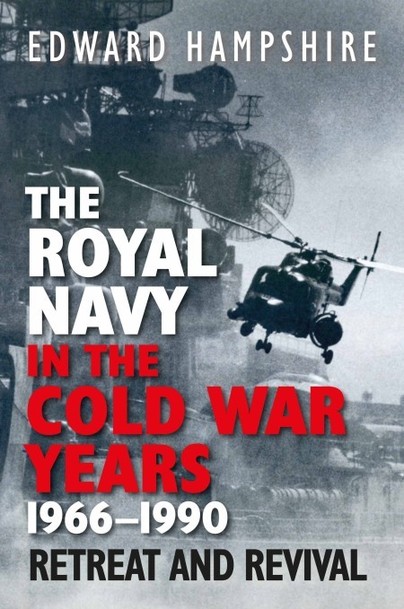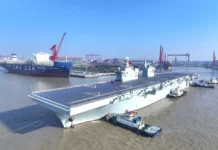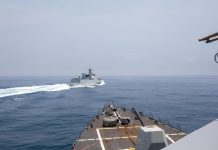
The Royal Navy in the Cold War years. !966-1990. Retreat and Revival. By Edward Hampshire. Seaforth Publishing, Barnsley, 2024. ISBN 978-1-3990-4122-5 (Hardback). 978-1-3990-4124-9 (E-Publication).
Reviewed by David Hobbs
Edward Hampshire has a bachelor’s degree in history from Magdalen College, Oxford, and a master’s degree in war studies from King’s College, London. He worked in the UK National Archive at Kew for ten years before lecturing at the Joint Services Command and Staff College, Shrivenham, and at the Royal Military Academy, Sandhurst.
He is now a historian in the Naval Historical Branch and a member of the Naval Staff’s analytical team. This book is the result of the author’s extensive research and demonstrates a deep understanding of a complex period during which the Royal Navy attempted to counter the expansion of the Soviet Navy, contribute to NATO and Commonwealth defence whilst remaining within a UK defence budget that came under ever-growing scrutiny.
It covers the complete range of naval matters from the procurement of the Trident missile system to the need to attract new recruits into an all-volunteer navy during periods of high civilian employment with better pay and conditions. The author makes use of documents only recently made available in the public domain to give unique insight into successive defence reviews and their impact on the Royal Navy’s global operations.
I cannot imagine that any contemporary historian has gained sufficient understanding to write a better book on this subject and it must, therefore, be considered as the definitive history of the Royal Navy from the immediate post-Admiralty period up to the collapse of the Soviet Union and the end of the Cold War.
The focus is firmly on the RN during a critical period of its long history but there is much that Australian readers will find to be of absorbing interest. The RAN decision to procure USN Charles F Adams class destroyers rather than the RN County class with its obsolescent Seaslug missile system, the possibility of procuring a common light destroyer design and, of course, the sale of the aircraft carrier Invincible to the RAN as part of the notorious 1981 Nott Defence Review are examples but there are many others.
The theme that runs throughout the text, however, is the failure of the naval staff to convince the wider Ministry of Defence, MOD, and politicians that aircraft carriers and the variety of aircraft types that they operate form a fundamental element of naval operations that cannot be replaced by a handful of land-based aircraft that may or may not be able to rely on in-flight refuelling from tanker aircraft to reach the area of operations, a shortcoming with which Australian readers are only too familiar.
For much of the period covered the newly-created MOD, within which the former Admiralty element was dominated by the larger former army and air force elements, was fixated by the role of providing troops for the NATO ‘central front’ between West and East Germany as the nation’s most important defence priority. Anything else including the defence of Britain’s world-wide seaborne trading links, NATO maritime operations in the Atlantic and Mediterranean theatres, treaty obligations and the defence of interests in the Far East together with amphibious capabilities on the NATO flanks were seen as secondary roles at best.
Somehow, the reviews also forgot the collective defence of Commonwealth nations and the British Overseas Territories. The failure of politicians to grasp the fundamental importance of a maritime strategy to an island nation like the UK which continues to rely on freedom of the seas for its livelihood is described with clarity.
By 1980 the UK’s contribution to NATO provided only 10% of the troops in Germany but over 75% of the naval forces assigned to the North East Atlantic, far more than other European nation. Naively, when Secretary of State for Defence John Nott carried out his poorly staffed 1981 Defence Review he assumed that the USA would not object to having to back-fill major British reductions from forces able to operate in the anti-submarine defence of the NATO Strike Fleet in the Atlantic.
The author reveals how wrong he was. The MOD focus on central Europe was apparent from the start of this period and meant that the naval staff had to fight a desperate battle to retain an aircraft carrier capability; a battle it lost in February 1966 when the proposed new carrier CVA-01, to have been named Queen Elizabeth, was cancelled with consequences that are still with today. The trauma this caused and the subsequent lengthy arguments to restore embarked aircraft to the RN order of battle are described at length and will resonate with Australians as having much in common with the cancellation of the Invincible purchase and the decision not to replace HMAS Melbourne.
The South Atlantic War of 1982 shocked British politicians who had forgotten what the Royal Navy was capable of achieving and even why the nation needed that capability. The conflict, what it achieved and its lasting impact are described in the degree of detail that one would expect from the earlier part of the book. The first part of this book had described the RN’s gradual retreat from the global role it had carried out for centuries, the second part describes its partial revival.
I served in the RN throughout the period covered by Edward Hampshire’s book. I was a midshipman in HMS Bastion, a tank landing craft based in Bahrain, in February 1966 and I vividly remember the shock as the Senior Naval Officer Persian Gulf called us together in the shore base wardroom to announce the cancellation of CVA-01.
I was in a naval staff desk job in London during both the 1981 Defence Review and the South Atlantic War of 1982 and my memories of both have been enhanced by the wider perspective explained so well in this book.
There is a great deal to be learned from it about the formulation and implementation of defence policies and it must be considered an essential read for both naval professionals and civilians who work within Defence Departments. Be aware, however, that it is a large book with the text running to 628 pages, 15 pages of Appendices and more than 50 pages of source notes. There are also 72 well chosen black and white photographs.
This book describes the big picture but includes a wealth of important detail and gives the reader insight into British defence and foreign policy during a fascinating period of history. Many of those policies had an impact on Australia and even those that did not have an interesting synergy.
The naval staff did not always produce the best arguments and Hampshire makes the point that on several occassions they failed to achieve an aim that should have been within their grasp or even failed to understand changing requirements fully. The need to get anti-submarine helicopters to sea in significant numbers being an example of the latter. These shortcomings, as well as the many successes, are all the more reason why the period covered so eloquently in this book must be studied and fully understood by the widest possible readership. Put simply, it is an outstanding work of scholarship and I give it my highest recommendation.



